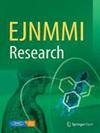在嗜铬细胞瘤的诊断成像中,[18F]FDOPA PET/CT 优于[68Ga]DOTATOC PET/CT
IF 3.1
3区 医学
Q1 RADIOLOGY, NUCLEAR MEDICINE & MEDICAL IMAGING
引用次数: 0
摘要
[18F]FDOPA(FDOPA)和[68Ga]DOTATOC PET/CT(DOTATOC)都被广泛用于检测嗜铬细胞瘤/副神经管瘤(PPGL)。然而,对这两种示踪剂性能的直接比较仅在小范围内进行。我们对 FDOPA 和 DOTATOC 进行了回顾性比较分析,以评估它们在根据怀疑 PPGL 而用药时检测 PPGL 的灵敏度和准确性。我们连续纳入了因怀疑 PPGL 或 PPGL 复发而转诊的患者,他们均接受了 FDOPA 和 DOTATOC 扫描。由两名经验丰富的观察者对两次扫描进行回顾性复查,他们对最终诊断结果是盲法。评估以肉眼和定量的方式进行。最终诊断主要以病理学为依据。共纳入 113 名患者(97 名疑似原发性 PPGL,16 名疑似复发)。在这 97 例患者中,51 例为嗜铬细胞瘤(PCC)(共 55 个病灶),6 例为副神经节瘤(PGL)(共 7 个病灶)。FDOPA 检测出并正确定位了所有 55 个 PCC,而 DOTATOC 仅检测出 25 个(灵敏度为 100%对 49%,p < 0.0001;特异性为 95%对 98%,p = 1.00)。与 DOTATOC 相比,FDOPA 的阴性预测值(100% 对 63%,p < 0.001)和诊断准确率(98% 对 70%,p < 0.01)更高。FDOPA发现了6例产生激素的PGL患者中的6例,其中1例在DOTATOC检测中呈阴性。FDOPA 和 DOTATOC 对 16 例疑似复发的既往 PPGL 患者的诊断效果相似。在 PCC 定位方面,FDOPA 优于 DOTATOC。与 DOTATOC 相比,FDOPA 也能识别所有 PGL,但患者数量有限。本文章由计算机程序翻译,如有差异,请以英文原文为准。
[18F]FDOPA PET/CT is superior to [68Ga]DOTATOC PET/CT in diagnostic imaging of pheochromocytoma
Both [18F]FDOPA (FDOPA) and [68Ga]DOTATOC PET/CT (DOTATOC) are widely used for detection of pheochromocytomas/paraganglioma (PPGL). However, direct comparisons of the performance of the two tracers are only available in small series. We conducted a retrospective comparative analysis of FDOPA and DOTATOC to assess their sensitivity and accuracy in detecting PPGL when administered based on suspicion of PPGL. We consecutively included patients referred on suspicion of PPGL or PPGL recurrence who were scanned with both FDOPA and DOTATOC. Both scans were reviewed retrospectively by two experienced observers, who were blinded to the final diagnosis. The assessment was made both visually and quantitatively. The final diagnosis was primarily based on pathology. In total, 113 patients were included (97 suspected of primary PPGL and 16 suspected of recurrence). Of the 97 patients, 51 had pheochromocytomas (PCC) (in total 55 lesions) and 6 had paragangliomas (PGL) (in total 7 lesions). FDOPA detected and correctly localized all 55 PCC, while DOTATOC only detected 25 (sensitivity 100% vs. 49%, p < 0.0001; specificity 95% vs. 98%, p = 1.00). The negative predictive value (100% vs. 63%, p < 0.001) and diagnostic accuracy (98% vs. 70%, p < 0.01) were higher for FDOPA compared to DOTATOC. FDOPA identified 6 of 6 patients with hormone producing PGL, of which one was negative on DOTATOC. Diagnostic performances of FDOPA and DOTATOC were similar in the 16 patients with previous PPGL suspected of recurrence. FDOPA is superior to DOTATOC for localization of PCC. In contrast to DOTATOC, FDOPA also identified all PGL but with a limited number of patient cases.
求助全文
通过发布文献求助,成功后即可免费获取论文全文。
去求助
来源期刊

EJNMMI Research
RADIOLOGY, NUCLEAR MEDICINE & MEDICAL IMAGING&nb-
CiteScore
5.90
自引率
3.10%
发文量
72
审稿时长
13 weeks
期刊介绍:
EJNMMI Research publishes new basic, translational and clinical research in the field of nuclear medicine and molecular imaging. Regular features include original research articles, rapid communication of preliminary data on innovative research, interesting case reports, editorials, and letters to the editor. Educational articles on basic sciences, fundamental aspects and controversy related to pre-clinical and clinical research or ethical aspects of research are also welcome. Timely reviews provide updates on current applications, issues in imaging research and translational aspects of nuclear medicine and molecular imaging technologies.
The main emphasis is placed on the development of targeted imaging with radiopharmaceuticals within the broader context of molecular probes to enhance understanding and characterisation of the complex biological processes underlying disease and to develop, test and guide new treatment modalities, including radionuclide therapy.
 求助内容:
求助内容: 应助结果提醒方式:
应助结果提醒方式:


